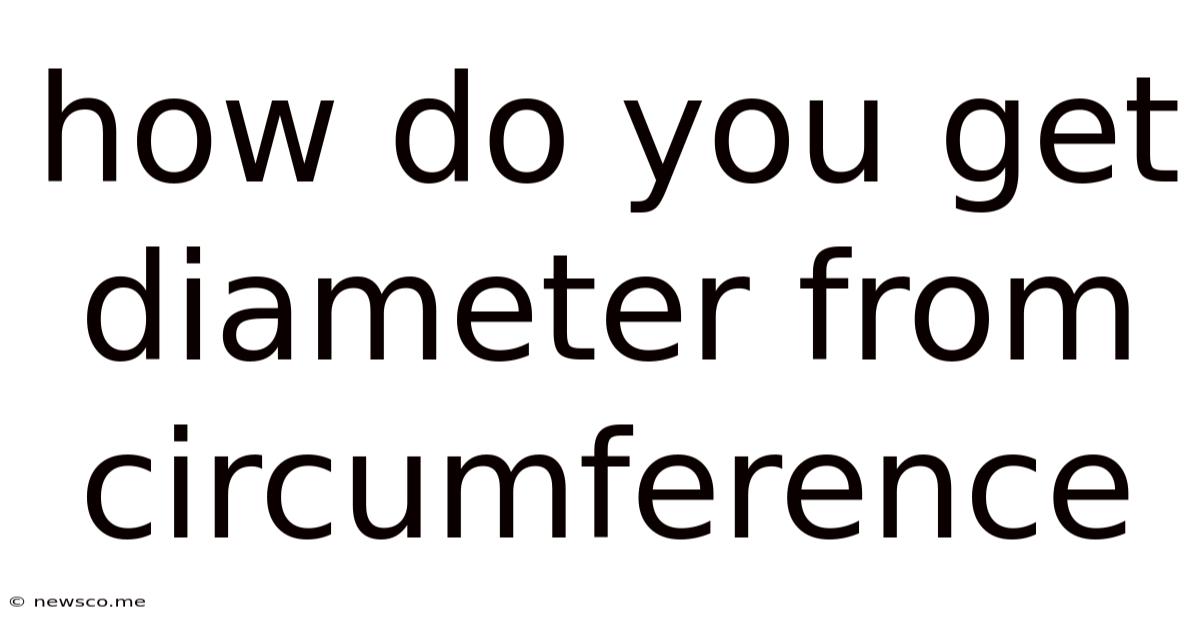How Do You Get Diameter From Circumference
News Co
May 08, 2025 · 4 min read

Table of Contents
How Do You Get Diameter from Circumference? A Comprehensive Guide
Knowing how to calculate the diameter from the circumference is a fundamental concept in geometry with wide-ranging applications in various fields. This comprehensive guide will explore this relationship, providing you with not only the formula but also a deeper understanding of the underlying principles, practical examples, and troubleshooting tips. We'll also delve into related concepts and explore how this calculation plays a crucial role in different areas of study and everyday life.
Understanding the Relationship Between Diameter and Circumference
The diameter and circumference of a circle are intrinsically linked. The diameter is the straight line passing through the center of a circle and connecting two points on the circle's edge. The circumference, on the other hand, is the total distance around the circle. This distance is directly proportional to the diameter.
This proportional relationship is beautifully encapsulated in the mathematical constant π (pi). Pi is the ratio of a circle's circumference to its diameter, approximately equal to 3.14159. This means that for any circle, no matter its size, the circumference is always approximately 3.14159 times its diameter.
The Formula: Deriving Diameter from Circumference
The fundamental formula linking circumference (C) and diameter (d) is:
C = πd
To find the diameter (d) when you know the circumference (C), we simply rearrange the formula:
d = C/π
This simple yet powerful formula allows us to easily calculate the diameter of a circle if we know its circumference.
Step-by-Step Calculation: Practical Examples
Let's solidify our understanding with some practical examples:
Example 1: Finding the Diameter of a Circular Flowerbed
Imagine you're landscaping your garden and need to determine the diameter of a circular flowerbed. You measure the circumference using a tape measure and find it to be 18.84 meters. To find the diameter:
-
Identify the known value: Circumference (C) = 18.84 meters
-
Use the formula: d = C/π
-
Substitute the known value: d = 18.84 meters / π (Using π ≈ 3.14159)
-
Calculate the diameter: d ≈ 6 meters
Therefore, the diameter of your circular flowerbed is approximately 6 meters.
Example 2: Calculating Diameter from a Circular Track's Circumference
A running track has a circumference of 400 meters. To find the diameter:
-
Known value: Circumference (C) = 400 meters
-
Formula: d = C/π
-
Substitution: d = 400 meters / π
-
Calculation: d ≈ 127.32 meters
The diameter of the running track is approximately 127.32 meters.
Handling Different Units of Measurement
The formula remains consistent regardless of the units used for circumference. If the circumference is given in centimeters, the diameter will be in centimeters. Similarly, if the circumference is in inches, feet, or kilometers, the diameter will be in the same units. Maintaining consistency in units is crucial for accurate calculations.
Beyond the Basic Formula: Exploring Related Concepts
Understanding the diameter-circumference relationship opens doors to exploring related geometrical concepts:
Radius
The radius (r) of a circle is half its diameter. Therefore, once you've calculated the diameter, finding the radius is straightforward:
r = d/2
Area
The area (A) of a circle is calculated using the formula:
A = πr²
Since we know the relationship between diameter and radius, we can also express the area in terms of the diameter:
A = π(d/2)² = πd²/4
This allows us to calculate the area of a circle if we only know its diameter or circumference.
Applications in Real-World Scenarios
The ability to calculate diameter from circumference is essential in various fields:
-
Engineering: Designing circular components, calculating pipe diameters, and determining the dimensions of wheels and gears.
-
Architecture: Planning circular structures, calculating the dimensions of domes and arches, and designing circular spaces.
-
Cartography: Determining the diameters of circular geographical features on maps.
-
Astronomy: Estimating the sizes of celestial bodies based on their apparent circumferences.
-
Manufacturing: Quality control of circular products ensuring consistency in size and shape.
Troubleshooting Common Mistakes
While the calculation itself is relatively simple, some common mistakes can occur:
-
Incorrect use of π: Using an inaccurate value of π can lead to significant errors. It's best to use a calculator with a built-in π function or use a value with sufficient decimal places (e.g., 3.14159).
-
Unit inconsistency: Ensure that the units of circumference and diameter are consistent throughout the calculation.
-
Mathematical errors: Double-check your calculations to avoid simple mistakes in division or substitution.
-
Using the wrong formula: Remember to always use the correct formula: d = C/π.
Advanced Considerations: Circles in Three Dimensions
While the focus has been on two-dimensional circles, the concept extends to three dimensions. For example, calculating the diameter of a sphere requires knowing its surface area or volume, which involves more complex formulas, but the underlying principle of the relationship between a linear dimension (diameter) and a related measure (surface area or volume) remains the same.
Conclusion: Mastering Diameter Calculation
The ability to calculate the diameter of a circle from its circumference is a fundamental skill with far-reaching applications. By understanding the underlying principles, mastering the formula, and practicing with various examples, you can confidently tackle real-world problems involving circular geometry. Remember to always double-check your calculations and use the appropriate value of π to ensure accurate results. With a little practice, this seemingly simple calculation can become a powerful tool in your mathematical arsenal.
Latest Posts
Related Post
Thank you for visiting our website which covers about How Do You Get Diameter From Circumference . We hope the information provided has been useful to you. Feel free to contact us if you have any questions or need further assistance. See you next time and don't miss to bookmark.